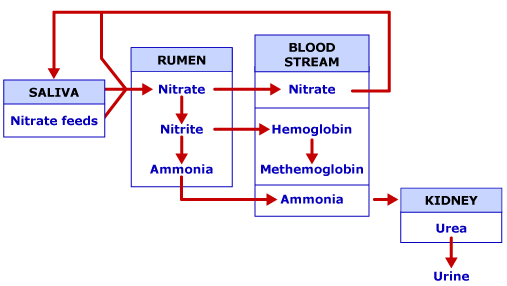|
|
 |
| Welcome | Getting Started | Resources | Site Map |
Week 4
Roughages |
Instructions for listening to audio clips
- Download the QuickTime Player to listen to the audio files.
- Read the QuickTime Instructions for installation help.
- Download the RealPlayer to listen to the audio files
- Instructions are on the RealPlayer download page
Classes of Forage - Grasses
Follow along with the audio...
- Forage classes
- Classes: grasses, legumes, forbes, and browse
- Primary grown forages
- Grasses and legumes
- Natural habitats
- Combination of four classes
- Forbes
- Primarily broadleaf, nonwoody plants
- Browse
- Woodier plants; herbaceous and softer component consumed
- Classifications of forage
- Annuals
- Survive one year or less
- Biennials
- Survive two years
- Perennials
- Survive at least three years
- Additional references
- Cited in text
- Electronic resources
- Grasses
- Gramineae family
- Feedstuff
- Additional agronomic properties
- Reduce soil N, contribute organic matter, improve soil texture, increase water holding capacity, and decrease erosion
- Figure 8.2 – Basic structure of grass plant
- Nutritional value as compared to legumes
- Lower in CP, digestible energy, Ca, and Mg
- Grow in range of conditions and perform range of functions
- Selection of grasses
- Climatic conditions
- Amount and timing of moisture, solar energy, heat
- Soil conditions
- Composition, fertility, and pH
- Soil test
- Critical nutrients for grasses
- N, P, K, Ca, Mg, S, and microminerals
- Nitrogen critical
- Limiting N will restrict nutritional value and yield
- Fulfill nutrient and dry-matter requirements for specific animals
- Nutritional value and yield varies
- By species and maturity at harvest
- Timing of availability
- Forage system may include grass and/or legume species
- Appropriate management required to maintain forage system
- Examples of management decisions for maintenance: selection, application rate, and timing of fertilizer and irrigation, method and timing of harvest, and management of species
- Classification
- Dependent on classification scheme
- Options include: cool-season, warm-season, temperate, tropical, or combination
- Temperate
- Only cool-season grasses or both cool- and warm-season grasses
- In this course, cool-season, warm-season, or tropical grasses
- Cool-season grasses
- Grow best in cool, moist climates
- Most productive in spring and fall
- Figure 8.3 – Growth patterns of grasses
- Generally, winter hardy
- Drought tolerance varies
- C3 grasses
- Examples: brome grasses, Kentucky bluegrass, tall fescue, orchardgrass, perennial ryegrass, reed canarygrass, and timothy
- Information on specific cool-season grasses refer to links above
- Warm-season grasses
- Grow best in summer
- Tolerant to high temperatures and drought
- Generally, not winter hardy
- Higher yields and poorer-quality forage compared to cool-season grasses
- C3 and C4
- Examples: bahiagrass, bermudagrass, bluestems, Indiangrass, carpetgrass, johnsongrass, and switchgrass
- Information on specific warm-season grasses refer to links above
- Forage cereals also forage grasses
- Pasture, silage, and hay
- Corn
- Silage
- Field residues
- Figure 8.4 - Cattle grazing corn field residues
- Oats
- Sorghum
- Presence of antinutritional cyanogenic glycosides
- Wheat
- Potential issues are bloat, grass tetany, and nitrate poisoning
- Primary issues for consideration for grasses
- Nitrate toxicity or nitrate poisoning
- Consumption of excessive levels of nitrate
- Primarily cattle, also may affect sheep and horses
- Etiology
- Microbes convert nitrate to nitrite
- Nitrite absorbed
- In bloodstream, nitrite combines with hemoglobin to form methemoglobin
- Methemoglobin does not transport oxygen
- Figure 8.5 – Pathways of nitrate in the ruminant
- Signs
- Respiratory distress, bluish mucous membranes, convulsions, and death
- Amount for toxicity varies
- Prevention
- Avoid excess nitrate in forages
- Consider fertilization rate and growing conditions
- Analyze questionable forages
- Ensiling of questionable forages
- Provide adequate energy
- Treatment
- Administration of methylene blue
- Grass tetany, grass staggers, or hypomagnesemia
- Complex disorder
- Caused by low blood Mg levels
- Generally, in ruminants consuming lush grass forages
- Immature forages have low Mg
- Additional factors contributing to grass tetany include high K, high N, and low Ca
- Signs
- Nervousness, incoordination, convulsions, and death
- Urine sample accurate guide for Mg
- Treatment
- Administration of Mg and/or Ca
- Prevention
- Provide supplemental Mg
- Feeding of Mg, feedstuff high in Mg, or administration of Mg to plant
- Planting legumes with grass forages
- Legumes higher in Mg
- Monitor Ca, N, and K in diet
- Endophyte toxicity
- Ruminants and horses
- Tall fescue and ryegrass
- Associated with turf versus forage varieties
- Endophyte
- Fungus
- Produce toxins detrimental to animals
- Lab analysis required for ID
- Signs in tall fescue
- Hyperthermia, decrease in production, reproductive problems, and tissue death
- Signs in ryegrass
- Poor muscle control
- Prevention
- Feed low-endophyte or endophyte-free grass forages




| |
| Welcome | Getting Started | Resources | SiteMap |